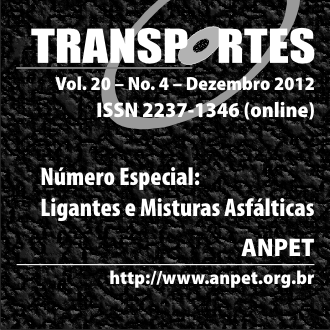Influence of the physical state of water in the diffusion process in asphalt binders
DOI:
https://doi.org/10.4237/transportes.v20i4.619Abstract
Moisture damage in asphalt mixtures is a complex phenomenon that involves mechanical, chemical, physical and thermodynamic processes. This damage contributes significantly to the premature deterioration of asphalt pavements, which leads to extra cost in highway maintenance and vehicle operations. One key mechanism of how moisture reaches the asphalt-aggregate interface is by its permeation or diffusion through the asphalt binder or mastic. For the asphalt-water system studied, the Fourier Transform Infrared (FTIR) – Attenuated Total Reflectance (ATR) spectrometry was used. Water shows strong absorption in the infrared region and the FTIR-ATR technique has the ability to monitor both the kinetics of moisture ingress as well as any chemical changes occurring during the test. This paper has the literature review and some results obtained in the comparison between water diffusion in the liquid state with the moisture (or vapor) state, both at room temperature.KEYWORDS: Asphalt Mixtures, Moisture Damage, Diffusion, Spectroscopy
Downloads
References
Arambula, E., Caro, S., and Masad, E. (2009). "Experimental Measurement and Numerical Simulation of Water Vapor Diffusion through Asphalt Pavement Materials." Journal of Materials in Civil Engineering, ASCE, submitted for evaluation.
Benjamin, I. (1994). "Vibrational Spectrum of Water at the Liquid/Vapor Interface." Physical Review Letters, 73(15), 2083.
Bertie, J. E., Labbe, H. J., and Whalley, E. (1969). "Absorptivity of Ice I in the Range 4000--30 cm[sup - 1]." The Journal of Chemical Physics, 50(10), 4501-4520.
Cheng, D. X., Little, D. N., Lytton, R. L., and Holste, J. C. (2003). "Moisture damage evaluation of asphalt mixtures by considering both moisture diffusion and repeated-load conditions." Bituminous Paving Mixtures 2003(1832), 42-49.
Du, Q., Superfine, R., Freysz, E., and Shen, Y. R. (1993). "Vibrational spectroscopy of water at the vapor/water interface." Physical Review Letters, 70(15), 2313.
Ewing, G. E., Foster, M., Cantrelll, W., and Sadtchenko, V. (2003). "Thin Film Water on Insulator Surfaces." Water in Confining Geometries, V. Buch and J. P. Devlin, eds., Springer-Verlag, Berlin, p. 179-211.
Falk, M., and Ford, T. A. (1966). "Infrared Spectrum and Structure of Liquid Water." Canadian Journal of Chemistry, 44, 1699-1707.
Griffiths, P. R., and de Haseth, J. A. (2007). Fourier Transform Infrared Spectrometry, Wiley-Interscience, a John Wiley & Sons Inc. Publication.
Jones IV, D. R. (1993). "SHRP Materials Reference Library: Asphalt Cements: A Concise Data Compilation." Report SHRP-A-645, Contract A-001, Strategic Highway Research Program, National Research Council, Washington, DC.
Kassem, E. A., Masad, E., Bulut, R., and Lytton, R. L. (2006). "Measurements of Moisture Suction and Diffusion Coefficient in Hot Mix Asphalt and their Relationships to Moisture Damage." Transportation Research Record: Journal of the Transportation Research Board, 1970, 45-54.
Kringos, N., Scarpas, A., and deBondt, A. (2008). "Determination of Moisture Susceptibility of Mastic-Stone Bond Strength and Comparison to Thermodynamical Properties." Journal of the Association of Asphalt Paving Technologists, 77, 435-478.
Nguyen, T., Byrd, E. W., Bentz, D., and Martin, J. (2005). "In Situ Spectroscopy Study of Water at the Asphalt/Siliceous Substrate Interface and Its Implication in Stripping." The Journal of Adhesion, 81, 1-28.
Sasaki, I., Moriyoshi, A., Hachiya, Y., and Nagaoka, N. (2006). "New test method for moisture permeation in bituminous mixtures." Journal of the Japan Petroleum Institute, 49(1), 33-37.
Shen, Y. R., and Ostroverkhov, V. (2006). "Sum-Frequency Vibrational Spectroscopy on Water Interfaces: Polar Orientation of Water Molecules at Interfaces." Chemical Reviews, 106(4), 1140-1154.
Vasconcelos, K. L., Bhasin, A., and Little, D. N. (2010). "Measurement of Water Diffusion in Asphalt Binders using the FTIR-ATR technique." Transportation Research Record, 2179, p. 29-38.
Wei, J. (2009). "Study on the Surface Free Energy of Asphalt, Aggregate and Moisture Diffusion in Asphalt Binder," China University of Petroleum, PhD.
Weis, D. D., and Ewing, G. E. (1998). "Absorption Anomalies in Ratio and Subtraction FT-IR Spectroscopy." Analytical Chemistry, 70(15), 3175-3183.
Wolf, R. V. (1991). Diffusion In and Through Polymers: Principles and Applications, Hanser Publishers, Munich Viennna New York Barcelona.
Downloads
Published
How to Cite
Issue
Section
License
Authors who submit papers for publication by TRANSPORTES agree to the following terms:
- The authors retain the copyright and grant Transportes the right of first publication of the manuscript, without any financial charge, and waive any other remuneration for its publication by ANPET.
- Upon publication by Transportes, the manuscript is automatically licensed under the Creative Commons License CC BY 4.0 license. This license permits the work to be shared with proper attribution to the authors and its original publication in this journal, and to be adapted for non-commercial purposes, provided appropriate credit is given and any derivative works are distributed under the same terms.
- Authors are authorized to enter into additional separate contracts for the non-exclusive distribution of the version of the manuscript published in this journal (e.g., publishing in an institutional repository or as a book chapter), with recognition of the initial publication in this journal, provided that such a contract does not imply an endorsement of the content of the manuscript or the new medium by ANPET.
- Authors are permitted and encouraged to publish and distribute their work online (e.g., in institutional repositories or on their personal websites) after the editorial process is complete. As Transportes provides open access to all published issues, authors are encouraged to use links to the DOI of their article in these cases.
- Authors guarantee that they have obtained the necessary authorization from their employers for the transfer of rights under this agreement, if these employers hold any copyright over the manuscript. Additionally, authors assume all responsibility for any copyright infringements by these employers, releasing ANPET and Transportes from any responsibility in this regard.
- Authors assume full responsibility for the content of the manuscript, including the necessary and appropriate authorizations for the disclosure of collected data and obtained results, releasing ANPET and Transportes from any responsibility in this regard.









